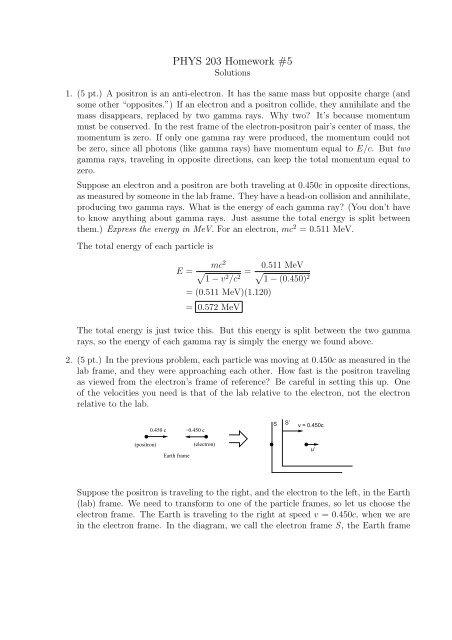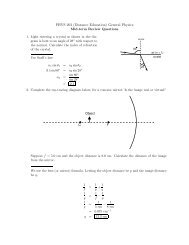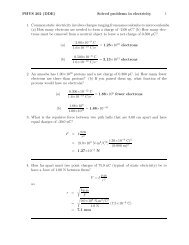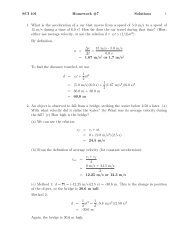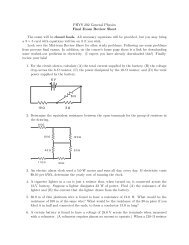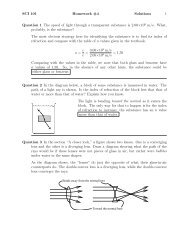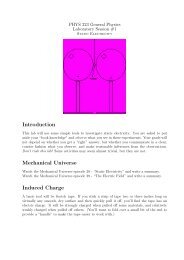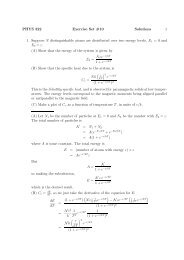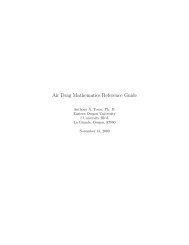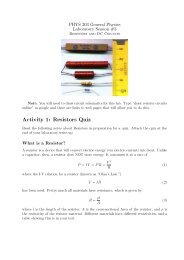You also want an ePaper? Increase the reach of your titles
YUMPU automatically turns print PDFs into web optimized ePapers that Google loves.
<strong>PHYS</strong> <strong>203</strong> <strong>Homework</strong> <strong>#5</strong><br />
Solutions<br />
1. (5 pt.) A positron is an anti-electron. It has the same mass but opposite charge (and<br />
some other “opposites.”) If an electron and a positron collide, they annihilate and the<br />
mass disappears, replaced by two gamma rays. Why two It’s because momentum<br />
must be conserved. In the rest frame of the electron-positron pair’s center of mass, the<br />
momentum is zero. If only one gamma ray were produced, the momentum could not<br />
be zero, since all photons (like gamma rays) have momentum equal to E/c. But two<br />
gamma rays, traveling in opposite directions, can keep the total momentum equal to<br />
zero.<br />
Suppose an electron and a positron are both traveling at 0.450c in opposite directions,<br />
as measured by someone in the lab frame. They have a head-on collision and annihilate,<br />
producing two gamma rays. What is the energy of each gamma ray (You don’t have<br />
to know anything about gamma rays. Just assume the total energy is split between<br />
them.) Express the energy in MeV. For an electron, mc 2 = 0.511 MeV.<br />
The total energy of each particle is<br />
E =<br />
mc 2<br />
√<br />
1 − v2 /c 2 =<br />
= (0.511 MeV)(1.120)<br />
= 0.572 MeV<br />
0.511 MeV<br />
√<br />
1 − (0.450)<br />
2<br />
The total energy is just twice this. But this energy is split between the two gamma<br />
rays, so the energy of each gamma ray is simply the energy we found above.<br />
2. (5 pt.) In the previous problem, each particle was moving at 0.450c as measured in the<br />
lab frame, and they were approaching each other. How fast is the positron traveling<br />
as viewed from the electron’s frame of reference Be careful in setting this up. One<br />
of the velocities you need is that of the lab relative to the electron, not the electron<br />
relative to the lab.<br />
0.450 c<br />
−0.450 c<br />
S S’<br />
v = 0.450c<br />
(positron)<br />
Earth frame<br />
(electron)<br />
u’<br />
Suppose the positron is traveling to the right, and the electron to the left, in the Earth<br />
(lab) frame. We need to transform to one of the particle frames, so let us choose the<br />
electron frame. The Earth is traveling to the right at speed v = 0.450c, when we are<br />
in the electron frame. In the diagram, we call the electron frame S, the Earth frame
S ′ , and the speed of the positron is u ′ in S ′ . We can now apply the velocity addition<br />
relation:<br />
u = v + u′<br />
1 + vu′<br />
c 2<br />
0.450c + 0.450c<br />
=<br />
1 + (0.450) 2<br />
= 0.75c<br />
3. (4 pt.) Suppose a rocket ship is approaching Earth at a speed of 0.80c. The rocket<br />
sends out a space probe toward Earth, launching it at a speed of 0.40c relative to the<br />
rocket. As measured by someone on Earth, how fast is the probe traveling<br />
Probe<br />
0.40c<br />
S S’<br />
v = 0.80c<br />
Rocket frame<br />
(sitting still)<br />
0.80c<br />
Earth<br />
u’<br />
In the diagram (left side), the we are in the rocket frame, with the Earth traveling left<br />
at 0.80c and the probe traveling to the right at 0.40c. We then transform to the Earth<br />
frame. On the right side of the diagram, the Earth frame is S and the rocket frame is<br />
S ′ . The speed of the probe in S ′ is u ′ = 0.40c. We apply the velocity addition relation:<br />
u = v + u′<br />
1 + vu′<br />
c 2<br />
0.80c + 0.40c<br />
=<br />
1 + (0.80)(0.40)<br />
= 0.91c<br />
4. (6 pt.) In a Young’s double-slit measurement, suppose that a helium-neon laser is used<br />
for the light source. The light has a wavelength of 633 nm. We measure the 8th-order<br />
bright fringe at 10.0 ◦ from the normal.<br />
(A) What is the separation between the two slits (Answer: 29.2 µm)<br />
We use the double-slit equation:<br />
d sin θ = mλ<br />
d sin 10.0 ◦ = (8)(0.633 µm)<br />
5.064 µm<br />
d = = 29.1 µm<br />
0.1736<br />
(B) Suppose we repeat the experiment, but this time we fill a fish tank with water<br />
and submerge the double slit in the water. When the laser light passes through the
slit, at what angle (from the normal) will the 8th-order bright fringe be seen (Recall:<br />
λ ′ = λ/n).<br />
The wavelength is now smaller, so the angle will be less:<br />
d sin θ = m λ n<br />
(8)(0.633 µm)<br />
sin θ =<br />
(29.1 µm)(1.33) = 0.131<br />
θ = 7.5 ◦<br />
5. (5 pt.) In the lab we have a diffraction grating which is labeled “600 lines/mm.” (A)<br />
Determine the separation between the lines on the grating, in µm.<br />
1 mm is 1000 µm, so to find the spacing in µm, we divide 1000 µm by 600:<br />
d =<br />
1000 µm<br />
600<br />
= 1.667 µm<br />
(B) If we shine light from an Argon-ion laser, with λ = 488 nm, on the grating at<br />
normal incidence, at what angle from the normal will each of the first three orders (m<br />
= 1, 2, and 3) of bright fringes occur<br />
We use the double-slit interference relation:<br />
d sin θ = mλ<br />
sin θ = mλ<br />
d<br />
(1)(0.488 µm)<br />
=<br />
1.667 µm = 0.2927<br />
θ = 17.0 ◦ for m = 1<br />
For m = 2, the value of sinθ is twice 0.2927:<br />
θ = arcsin 2(0.2927) = 35.8 ◦ for m = 2<br />
Similarly, for m = 3, the value of sinθ is three times 0.2927:<br />
θ = arcsin 3(0.2927) = 61.4 ◦ for m = 3<br />
(C) Will there be any other orders of constructive interference<br />
No, there will be no more orders of contructive interference, because 4(0.2927) is greater<br />
than 1, so there is no angle that will work for this. Another way to say it is, 4 times<br />
the wavelength is greater than the separation between slits (or scratches), so even at<br />
90 ◦ there cannot be a 4-wavelength difference between the path lengths of the light<br />
from adjacent slits.


